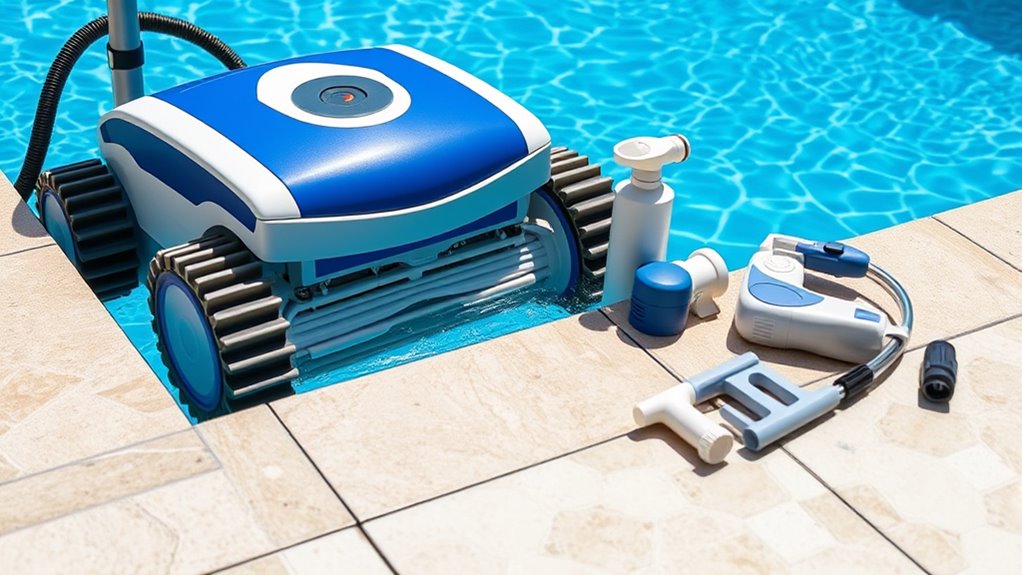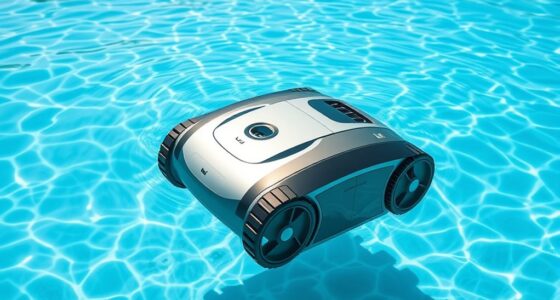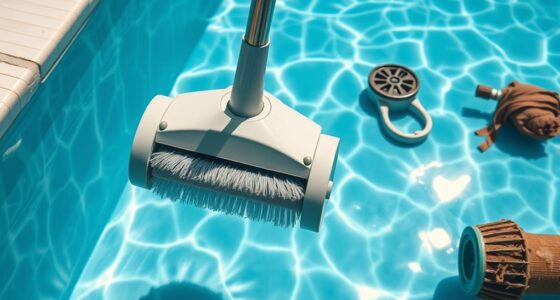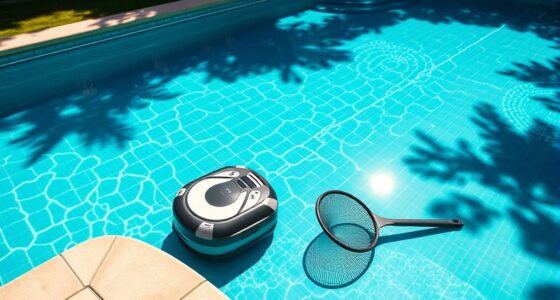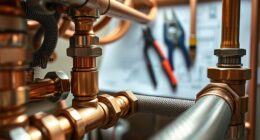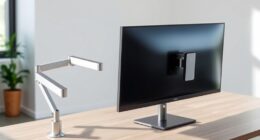To keep your automatic pool cleaner running smoothly, regularly inspect and replace worn brushes and wheels, clean the filter and debris bag weekly, and check for obstructions or damage. Guarantee the cables and power supply are safe and in good condition. During off-season, store the cleaner properly in a dry, cool place and follow troubleshooting tips for performance issues. Continuing with these tips will help you maintain your cleaner effectively and prolong its lifespan.
Key Takeaways
- Regularly inspect and replace brushes, wheels, tracks, and sensors to ensure optimal cleaning performance.
- Clean and check the filter and debris bag weekly to prevent blockages and maintain water flow.
- Conduct routine electrical safety checks on cables, connectors, and the power supply for reliability.
- Store the cleaner properly during off-season, cleaning and drying it thoroughly to extend lifespan.
- Maintain proper pool chemistry before replacing parts to prevent corrosion and ensure long-term device health.
Checking and Replacing Brushes and Wheels
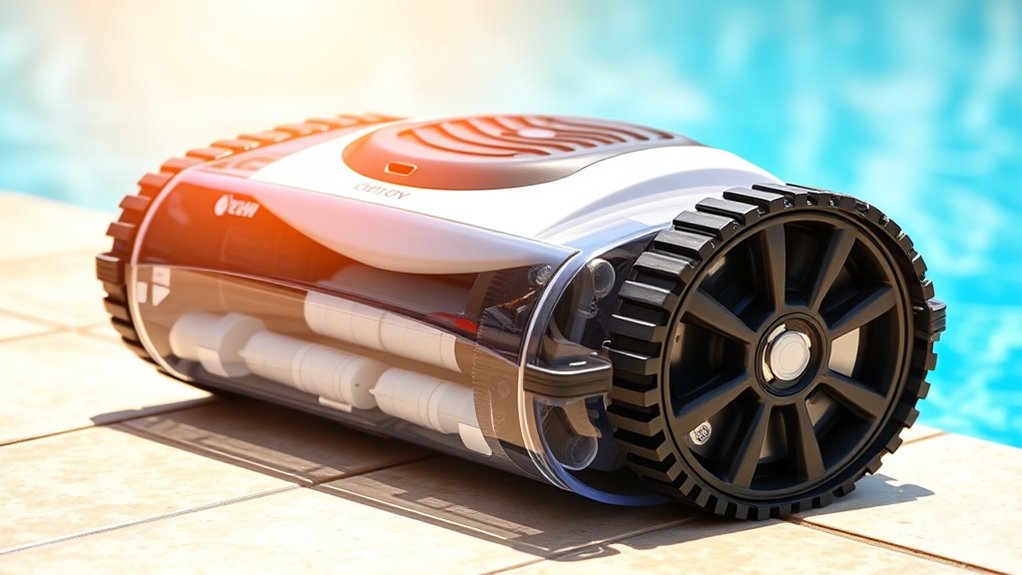
Regularly inspecting your automatic pool cleaner’s brushes and wheels guarantees it operates efficiently. For brush maintenance, check for signs of wear or damage, such as frayed bristles or uneven cleaning. Worn brushes reduce cleaning effectiveness, so replace them when necessary to ensure ideal performance. Wheel replacement is equally important; inspect wheels for cracks, flat spots, or sluggish movement. Damaged wheels can hinder the cleaner’s maneuverability and coverage. When replacing wheels, ensure you choose compatible parts to maintain proper operation. Regularly maintaining brushes and wheels prevents unnecessary strain on your cleaner’s motor and prolongs its lifespan. Proper HEPA filtration can help in removing allergens and pollutants that might otherwise affect your pool’s water quality, especially if you have pets or allergy sufferers in your household. Keeping these components in top shape ensures your pool stays clean with minimal effort and reduces the likelihood of breakdowns.
Cleaning and Inspecting the Filter and Debris Bag

Regularly cleaning your filter and debris bag guarantees your cleaner works efficiently. Keep an eye on how often you clean them and watch for signs of blockages that can hinder performance. Addressing these issues promptly helps prevent breakdowns and keeps your pool sparkling. Additionally, inspecting the sensor systems ensures your cleaner’s automatic functions operate correctly, maintaining optimal cleaning cycles. Maintaining proper indoor air quality in your equipment area can also help prolong the lifespan of your cleaner. Regular maintenance of the filter and debris bag is essential for early detection of potential issues that may affect cleaning efficiency. Incorporating preventive maintenance practices can further enhance the longevity and performance of your pool cleaner. Being aware of family photoshoot fails can also remind you of the importance of routine checks to prevent unexpected issues during your maintenance routine.
Filter Cleaning Frequency
How often should you clean and inspect your automatic pool cleaner’s filter and debris bag? It depends on usage and debris buildup, but generally, you should check weekly. Regular cleaning helps extend the filter’s lifespan and prevents debris accumulation that can reduce cleaning efficiency. If your pool is surrounded by trees or heavy debris, inspect more frequently. Incorporating AI-driven security systems can help monitor your pool equipment for potential issues, ensuring optimal operation. Additionally, understanding market trends and industry transformations can guide you in adopting new maintenance technologies. Being aware of filter maintenance best practices ensures your pool stays clean and functions efficiently. Moreover, staying informed about cybersecurity measures for your pool automation devices can protect your system from potential threats, maintaining a safe and secure environment.
Debris Bag Inspection
Ever wonder if your automatic pool cleaner’s debris bag needs attention? Regular inspection ensures *best possible* performance and keeps your pool water chemistry balanced. When you check the debris bag, look for clogs, tears, or debris buildup that could hinder cleaning efficiency. A full or damaged bag can disrupt water flow, affecting filtration and circulation. During seasonal maintenance, inspect the bag for wear and replace it if needed. Remember to remove debris carefully to avoid stirring up settled dirt. Visualize a bag filled with leaves, twigs, dirt, and insects—each item blocking water flow. Keep the bag clean to support your pool’s health and maintain a smooth cleaning cycle, especially during peak swimming season when debris tends to accumulate faster. Regularly inspecting the filtration system can also help prevent clogs and ensure optimal operation of your automatic pool cleaner. Additionally, understanding the relationship between proper maintenance and equipment longevity can motivate consistent care. Incorporating routine checks of your water circulation system can further enhance pool performance and extend the lifespan of your cleaning equipment. Moreover, paying attention to sound vibrations during operation can help identify early signs of mechanical issues before they become costly repairs. Regular maintenance also reduces the likelihood of costly repairs, saving you money in the long run.
Signs of Blockages
Are you noticing your automatic pool cleaner isn’t performing as efficiently as it used to? One common sign is reduced cleaning coverage or slow movement, which can indicate blockages in the filter or debris bag. These obstructions hinder pump efficiency, making the cleaner work harder and less effectively. Check for debris buildup or clogs that might block water flow. Additionally, poor sensor calibration can cause the cleaner to miss spots or stop prematurely, often caused by dirt or debris interfering with sensors. Regularly cleaning and inspecting the filter and debris bag helps maintain ideal pump efficiency and ensures sensors function correctly. It’s also helpful to consult your exploration and adventure manual or manufacturer guidelines for specific maintenance tips. If you notice a decline in performance, start by inspecting these components for blockages, and calibrate sensors if needed, to keep your pool spotless. Remember, understanding the local building codes and permits involved in any pool upgrades can help you avoid legal issues if you decide to make significant modifications. Additionally, staying informed about divorce laws in your area can be beneficial if legal advice becomes necessary for any related matters. Proper maintenance routines also contribute to the long-term durability of your pool equipment, ensuring it functions optimally for years to come.
Examining and Maintaining the Cables and Power Supply
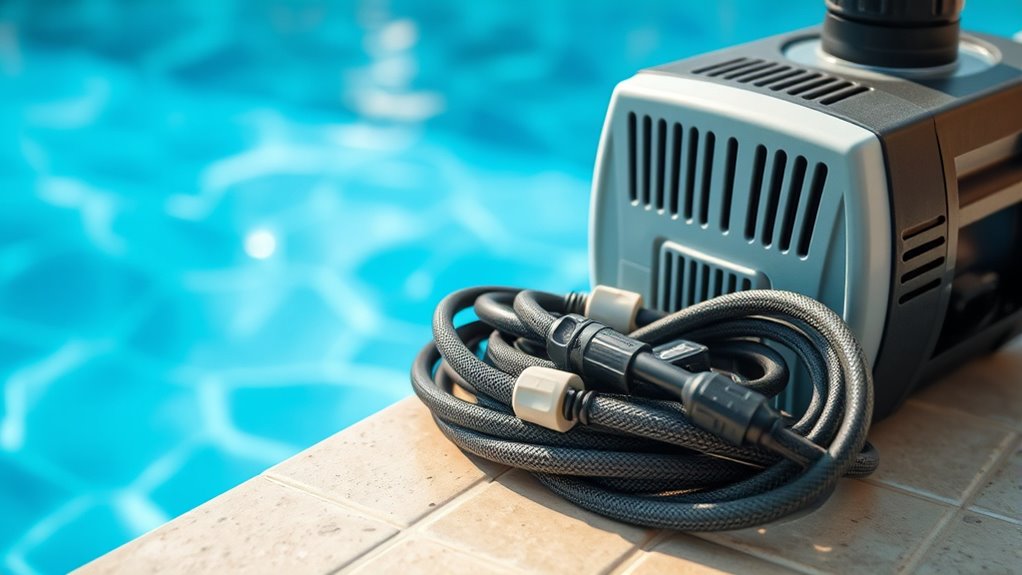
Regularly inspecting the cables and power supply guarantees your automatic pool cleaner operates smoothly. Check for cable integrity by looking for cuts, frays, or exposed wires that could hinder performance. Ensure the power supply is secure and free from moisture or corrosion, which could compromise power supply safety. Keep an eye on connections, making sure they’re tight and undamaged. Look for signs of wear or damage that might cause electrical issues or interrupt cleaning. Maintaining these components prevents unexpected malfunctions and prolongs the device’s lifespan. Additionally, inspecting self watering plant pots can provide insights into water management systems that ensure consistent operation. Regularly reviewing the source of power and understanding brand reputation can help confirm the reliability of your equipment. Properly managing electrical safety reduces the risk of hazards and ensures safe operation. Conduct periodic visual inspections to detect subtle cracks or frays before they worsen. Ensure cable movement doesn’t restrict cleaner’s operation. Being aware of electric motor performance can help identify early signs of malfunction that could affect cleaning efficiency.
Assessing and Replacing Worn or Damaged Tracks and Brushes
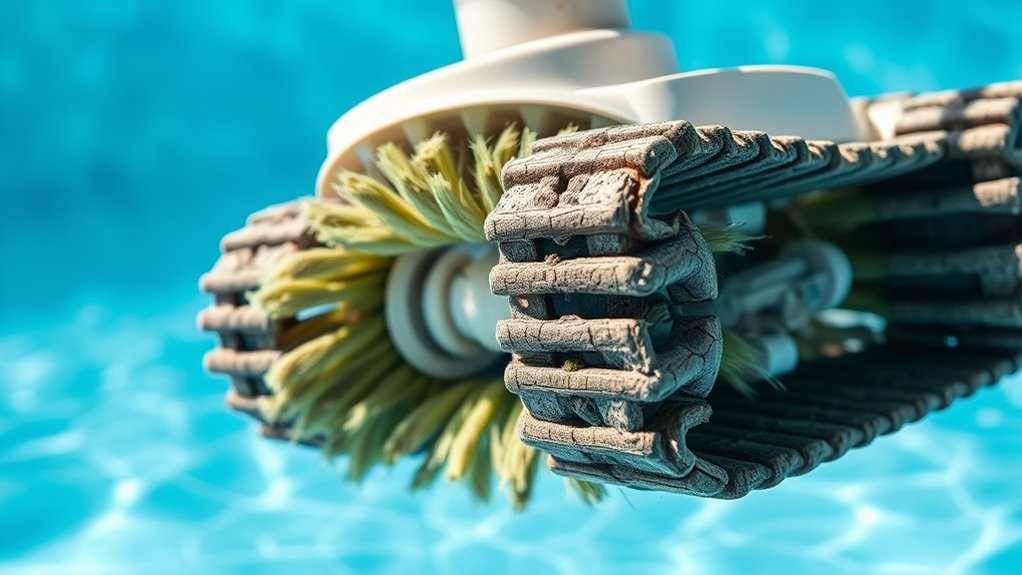
Start by looking for signs of wear on your cleaner’s tracks, like cracks or missing sections. Then, check the brushes to see if they’re frayed or worn down. If you notice any damage, it’s time to replace those components to keep your cleaner running smoothly. Additionally, using professional-grade products can help maintain the overall performance and longevity of your pool cleaner.
Identifying Track Wear Signs
Over time, worn or damaged tracks and brushes can markedly impair your pool cleaner’s performance. You might notice uneven cleaning, the cleaner skimming slowly, or it getting stuck. Signs of wear include misaligned tracks that wobble or slip, reduced wheel traction, and visible cracks or tears in the tracks. If the tracks aren’t tracking straight or seem loose, it’s a sign they need replacing. Check for uneven wear patterns that cause the cleaner to drift or miss spots. Also, listen for unusual noises or slipping sounds when the cleaner runs. These issues often stem from track misalignment or worn-out wheels. Regularly inspecting for these signs helps you catch problems early, ensuring your cleaner continues to operate efficiently.
Inspecting Brush Condition
Have you checked the condition of your pool cleaner’s brushes lately? Worn or damaged brushes can reduce cleaning efficiency and damage your pool’s surfaces. Inspect the brushes for fraying, missing bristles, or cracks, and guarantee they spin freely. Proper brush condition also helps maintain balanced pool chemistry by preventing debris buildup that can affect water quality. Always follow safety precautions—disconnect the cleaner from power before inspecting. If you notice signs of excessive wear, replace the brushes promptly to avoid further damage to the cleaner or pool surfaces. Regular checks save you time and money in the long run, ensuring your pool stays clean and safe. Keeping brushes in good shape is key to maintaining ideal pool chemistry and prolonging your cleaner’s lifespan.
Replacing Damaged Components
When you notice tracks or brushes are damaged or worn out, it is vital to assess their condition promptly. Damaged components can hinder cleaning efficiency and may cause further damage to your cleaner. Before replacing parts, confirm the pool chemistry is balanced to prevent corrosion or buildup. Always unplug the cleaner to maintain electrical safety during inspection. Visualize:
- Cracks or tears in the tracks
- Worn or missing brushes
- Debris lodged in tracks
- Rust or corrosion signs
- Unusual noises during operation
Replace worn or broken parts with compatible components, and double-check connections. Properly maintained tracks and brushes not only improve cleaning but also extend your cleaner’s lifespan. Prioritizing electrical safety and proper pool chemistry ensures a safe, effective replacement process.
Storing Your Cleaner During Off-Season

Proper storage during the off-season is essential to guarantee your automatic pool cleaner remains in good condition. Follow these storage tips to prevent damage and extend its lifespan. First, clean your cleaner thoroughly, removing dirt, debris, and any residual chemicals. Dry all parts completely to prevent mold and corrosion. Store your cleaner in a cool, dry place away from direct sunlight and extreme temperatures, which can degrade components. During seasonal precautions, avoid leaving the device in the water or damp environments for extended periods. Coil hoses neatly to prevent kinks, and keep the power cord untangled. By taking these simple steps, you guarantee your pool cleaner stays in excellent condition, ready for use when swimming season begins again.
Troubleshooting Common Performance Issues
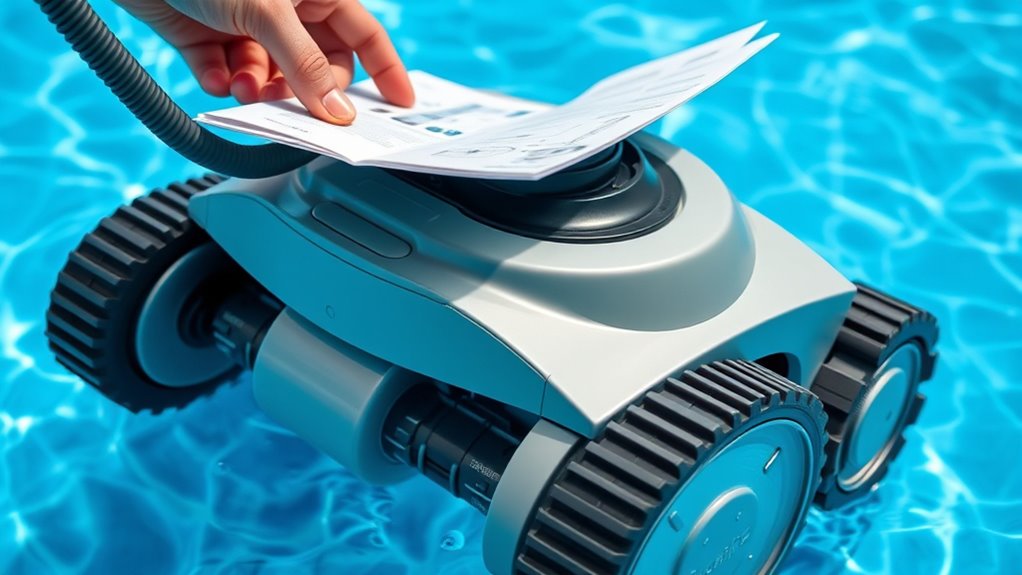
If your automatic pool cleaner isn’t performing as it should, troubleshooting can often identify and resolve common issues quickly. Start by checking the robotic programming settings through the user interface—sometimes, a reset or adjustment rectifies the problem. Ensure the power supply is stable and the connection is secure. Inspect the brushes and filters for debris or wear that could hinder movement. Examine the wheels and tracks for obstructions or damage. Finally, verify that the cleaner’s path is clear and that no obstacles block its navigation.
Check robotic settings, power stability, brushes, filters, wheels, and clear obstacles to troubleshoot your pool cleaner effectively.
- The cleaner gets stuck on steps or corners
- Poor cleaning coverage or missed spots
- Unusual noises during operation
- The unit doesn’t start or stops mid-cycle
- Remote control or app connectivity issues
Frequently Asked Questions
How Often Should I Schedule Professional Maintenance for My Pool Cleaner?
You should schedule professional maintenance for your pool cleaner at least once a year. During this visit, a routine inspection helps identify any issues, while a part replacement schedule guarantees key components stay in top shape. Regular professional checks prevent breakdowns and extend your cleaner’s lifespan. Keep an eye on performance and don’t wait too long between services, especially if you notice decreased cleaning efficiency or unusual noises.
Can I Use Chemical Cleaners on My Automatic Pool Cleaner?
You might wonder if chemical cleaning is safe for your automatic pool cleaner. It’s generally best to avoid harsh chemicals, as they can damage your cleaner’s components. Check your cleaner’s compatibility before using chemical cleaners, since some models are more sensitive. Instead, opt for gentle cleaning solutions and follow manufacturer instructions to keep your cleaner functioning properly. Regular rinsing with water also helps maintain cleaner performance without risking damage.
What Safety Precautions Should I Follow During Maintenance?
They say safety first, and that’s true when maintaining your automatic pool cleaner. Always follow electrical safety guidelines, ensuring the power is off before handling. Use proper handling techniques to avoid damage or injury. Keep water away from electrical parts, and wear gloves if needed. By staying cautious and attentive, you protect yourself and your equipment, making sure your pool stays clean and safe without any mishaps.
How Do I Upgrade My Cleaner’S Software or Firmware?
To upgrade your cleaner’s firmware or perform software upgrades, start by checking the manufacturer’s app or website for the latest updates. Download any available firmware updates, then connect your cleaner to your Wi-Fi network as instructed. Follow the app’s prompts to install the updates securely. Always make sure your device is charged or plugged in during the process to prevent interruptions. Regular updates keep your cleaner running efficiently and extend its lifespan.
Are There Eco-Friendly Options for Replacing Parts or Batteries?
You’re wondering if eco-friendly replacements for parts or batteries exist. You’ll find options like biodegradable batteries, which break down naturally and reduce environmental impact. When replacing parts, look for eco-friendly alternatives made from sustainable materials. By choosing biodegradable batteries and environmentally conscious parts, you help minimize waste and support sustainability. Always check with manufacturers for eco-friendly options, ensuring your pool cleaner remains efficient while being kinder to the planet.
Conclusion
Keeping your pool cleaner in top shape is like tending to a loyal friend, ensuring it glides effortlessly through sparkling waters. By regularly checking brushes, cleaning filters, and inspecting cables, you’re fueling its energy and extending its life. When you store it properly during off-season, you’re giving it a well-earned rest. With a little maintenance, your cleaner will dance gracefully across your pool, ready to keep your oasis pristine and inviting whenever you need it.
